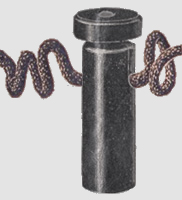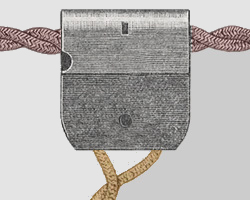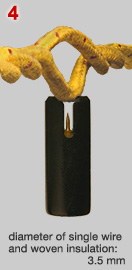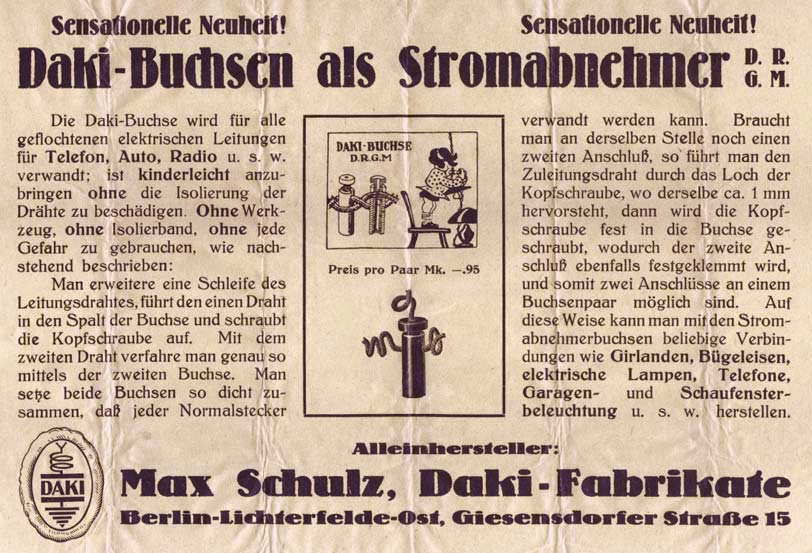 |
Daki-Buchse and
T.E.G prise, to branche off current from cords |
| Daki - Buchse | Prise universelle de courant T.E.G. | |
 |
 |
| German Daki and French T.E.G. connectors offered the possibility to branche
off
current from twisted cords. Both connector types
use sharp needes to penetrate cord insulation and making contact with
the copper wire. Two Daki connectors are necessary to tap a twisted
cord. The T.E.G. connector has two separate needles. A box with two Daki-Buchsen has been donated by Reiner Hahn. The prise universelle de courant "T.E.G." is not a museum item. Click T.E.G. image for details. |
 |
 |
 |
 |
| 1 | A Bakelite
Daki connector (Buchse) consists of two parts: (i) a 28.2 mm long tube with two 7.6 mm deep gaps opposite of each other. The inner part of the tube has a copper, 4.5 mm long, sharp needle. The needle is connected to a contact for a 4.0 mm plug pin (see image 3). (ii) a hollow screw head. {RH} |
| 2 | Magnification
of the connector top half. A modern wire is used to illustrate
the method of branching off current. Left: a short piece of wire (conducting copper filaments and intact insulation) fits exactly in the 2.0 mm wide gap. Right: screwing down the Bakelite head presses the wire down. The sharp copper pin punctures the wire insulation and makes contact with the copper filaments. |
| 3 | Connectors
are connected to each of the twisted wires (same type as shown in image
2).
A standard (6A) plug with 4.0 mm pins and attached cord connects the
pair of Daki connectors to an appliance. To show pin connection clearly
the
plug is not fully inserted in the Daki connectors, but connector length
is sufficient for full insertion. Plugs are not a
part of Daki-Buchse packages. A Daki connector can be used only with a single wire. Twisted cords were used in the past, among others for hanging lamps (see image shown in manual below). Modern cords with two wires surrounded by an additional overall insulation can't be used. |
| 4 | The
Daki manual mentions two types of applications: extra low voltage
(telephones, cars, radio etc.), and 110 / 220 Volt appliances
(ligthing,
irons etc.). The second category of
applications asks for considerable thicker cords than shown in images 2
and 3. Image 4 shows that an attempt to branch off an old 220V twisted cord failed. Thinner (110V ?) cords may have existed. |
 |
Daki
connectors offer also the possibility to use the screw head for the
branched off wire (yellow wire in image left). The wire has to be
inserted a bit further than full length of the head. The head must
screwed further down than shown in image 2 to
be sure that the needle appears at the other side of the power wire
(red)
to make sufficient contact with the wire in the screw head.
|
In principle the method works, but a
stable fixation of the branched off wire in the hollow screw head is
difficult. The procedure shown in images 2 and 3 is a more
reliable method. The manual suggests that the Daki connectors can be used safely to connect an iron. Possible, but not advisable. Extra low voltage applications are more safe. Daki connectors do not have a VDE certification. |
 |
| Sensational
novelty! Daki connectors as
pantographs D.R.G.M.* |
The Daki connector is used for all braided electrical cords for telephones, cars, radios, etc.; is very easy to attach without damaging the insulation of the wires. Without tools, without insulating tape and usable without any risk, as described below. Create some space between the power wires and insert one of the wires into the gap of the connector. Do the same with the second wire using the second connector. Put both connectors so close together that any standard plug can be used. |
If you need a second connection at the same point, put another wire through the hole in the head screw, it must protrude approx. 1 mm, then the head screw is screwed tightly into the connector, to clamp the second connection wire also, use the other screw head for a second connection of the other wire. In this way, any desired connection is poossible, such as garlands, irons, electric lamps, telephones, garage and shop window lighting, etc. |
| Sole manufacturer: Max Schulz,
Daki-products Berlin-Lichterfelde-Ost, Giesendorfer
Straße 15 * Deutsches Reich Gebraugsmuster (German Reich Registered Design; see link for details) |
 |
| The universal socket "T.E.G." for flexible cords Patented S.G.D.G* recommended to all: ELECTRICIENS, TRADERS, INDUSTRIALISTS, INDIVIDUALS Use it ! It will give you complete satistaction ! E. Gaillemin manufacturer 24 Rue de la République Saint-Mandé (Seine) * S.G.D.G = Sans Garantie Du Gouvernement (patent without government guarantees; see link ) |
 |
a.
cover b. socket base c. socket needle d. mains twisted cord e. screw to attach cord (f) to needle f. branched off cord g. plate for wall mounting cover (a) h. adapter for lamp socket i. bolt to fasten adapter to base (b) k. lamp socket (optional) Images are based on T.E.G. manual |
 |
| The
Prise universelle de courant "T.E.G." was presented at the
Concours
Lépine 1920 (trade fair for inventors to show new designs) and has been
awarded with a silver medal. Whether the invention was a commercial
success is unclear, but it could have inspired Max Schulz to design
his Daki-Buchse. The significance of the abbreviation T.E.G. has not
been found. |
|
| 5 | The
basic
T.E.G. module consists of two parts: (1) socket with two needles to
punch flexible, twisted power wires. Needles are connected to contacts
to fasten the
branched off cord, and (2) a cover with insulation inside to shield the
needles. |
| 6 | Two additional parts
could be ordered: (1) a plate for wall mounting the basic module,
and (2) a lamp adapter to fasten on the socket. The lamp
socket is not a part of the T.E.G. package. |
| |
D i g i t a l M u s e u m o f | |
P l u g s a n d S o c k e t s | |